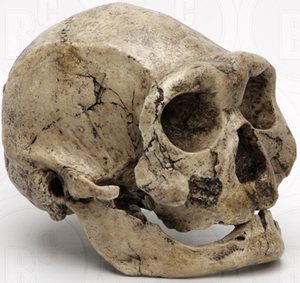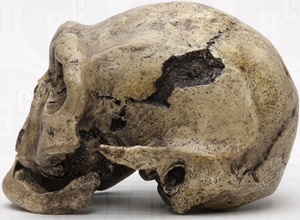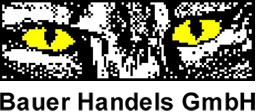Mensch: Stammesgeschichte
Homo erectus
Homo erectus
Alter ca. 1.7 Millionen Jahre. Dieser Schädel (D3444) wurde bei Grabungen 2002 in Georgien gefunden, der passende Unterkiefer (D3900) 2003. Es ist schwierig zu bestimmen, ob der Zahnverlust ein Ergebnis fortschreitenden Alters oder aufgrund einer Krankheit war. Aufgrund erheblichen Knochenschwundes sowohl des Ober- und Unterkiefers kann gesagt werden, dass der Zahnverlust Jahre vor dem Tod stattgefunden hat. Es wird vermutet, dass diese Person entweder in der Lage war, ohne Hilfe zu überleben, indem sie weiche Lebensmittel konsumierte oder dass andere Hominiden der Lage waren, für diese Person zu sorgen.
Passender Sockel auf Anfrage (Artikel S-BH-054)
Beschrieb in Englisch:
Dmanisi Homo erectus Skull 4
1.7 MYA. The Dmanisi site in the country of Georgia has yielded incredible hominin fossil finds of the species Homo erectus, adding further documentation to the presence of Homo existing outside of Africa around 1.7 million years ago during the Plio-Pleistocene period. This specimen is one of five individuals found in the same area and provides a unique insight into the morphological variation within a small population sample of human ancestors.
Dmanisi D3444/D3900 is believed to be a Homo erectus adult male with a marked edentulous (toothless) grin. The cranium (D3444) was found first and the mandible (D3900) was found later, immediately adjacent to the spot the cranium was found. These specimens were discovered during the 2002-2003 excavation season at the Dmanisi site. It is difficult to determine if tooth loss was a result of either advancing age or pathology. However, due to substantial bone resorption (bone loss) of both the mandible and maxilla, tooth loss occurred years before death. It is hypothesized that this individual either was able to survive without help by consuming soft foods or that other Dmanisi hominins were able to help care for this individual. The Dmanisi hominins offer an incredible glimpse of early human development, within group variation, and hominin migration patterns and would be an invaluable addition to any anthropology, paleoanthropology or bioarchaeology programs.
The Bone Clones® Hominid line is composed of discoveries from anatomically modern humans, archaic humans, early Homo, early hominins, and other hominids. The majority of the casts in this line have been recreated by our team of anatomical sculptors. Some are reconstructions made by anthropology professionals using fragmentary elements from original discoveries and extrapolating the missing parts from those (i.e. Neanderthal skeleton). A small portion of the hominin line has been cast from original material. 2-part skull (separate cranium & jaw).
Beschrieb in Englisch:
Dmanisi Homo erectus Skull 4
1.7 MYA. The Dmanisi site in the country of Georgia has yielded incredible hominin fossil finds of the species Homo erectus, adding further documentation to the presence of Homo existing outside of Africa around 1.7 million years ago during the Plio-Pleistocene period. This specimen is one of five individuals found in the same area and provides a unique insight into the morphological variation within a small population sample of human ancestors.
Dmanisi D3444/D3900 is believed to be a Homo erectus adult male with a marked edentulous (toothless) grin. The cranium (D3444) was found first and the mandible (D3900) was found later, immediately adjacent to the spot the cranium was found. These specimens were discovered during the 2002-2003 excavation season at the Dmanisi site. It is difficult to determine if tooth loss was a result of either advancing age or pathology. However, due to substantial bone resorption (bone loss) of both the mandible and maxilla, tooth loss occurred years before death. It is hypothesized that this individual either was able to survive without help by consuming soft foods or that other Dmanisi hominins were able to help care for this individual. The Dmanisi hominins offer an incredible glimpse of early human development, within group variation, and hominin migration patterns and would be an invaluable addition to any anthropology, paleoanthropology or bioarchaeology programs.
The Bone Clones® Hominid line is composed of discoveries from anatomically modern humans, archaic humans, early Homo, early hominins, and other hominids. The majority of the casts in this line have been recreated by our team of anatomical sculptors. Some are reconstructions made by anthropology professionals using fragmentary elements from original discoveries and extrapolating the missing parts from those (i.e. Neanderthal skeleton). A small portion of the hominin line has been cast from original material. 2-part skull (separate cranium & jaw).




Hersteller:
| Bone Clones |  |
Zusatzhinweis:
Passender Sockel auf Anfrage verfügbar (Art.-Nr. S-BH-054).
Alle Preise zuzüglich MwSt und Versandkosten

